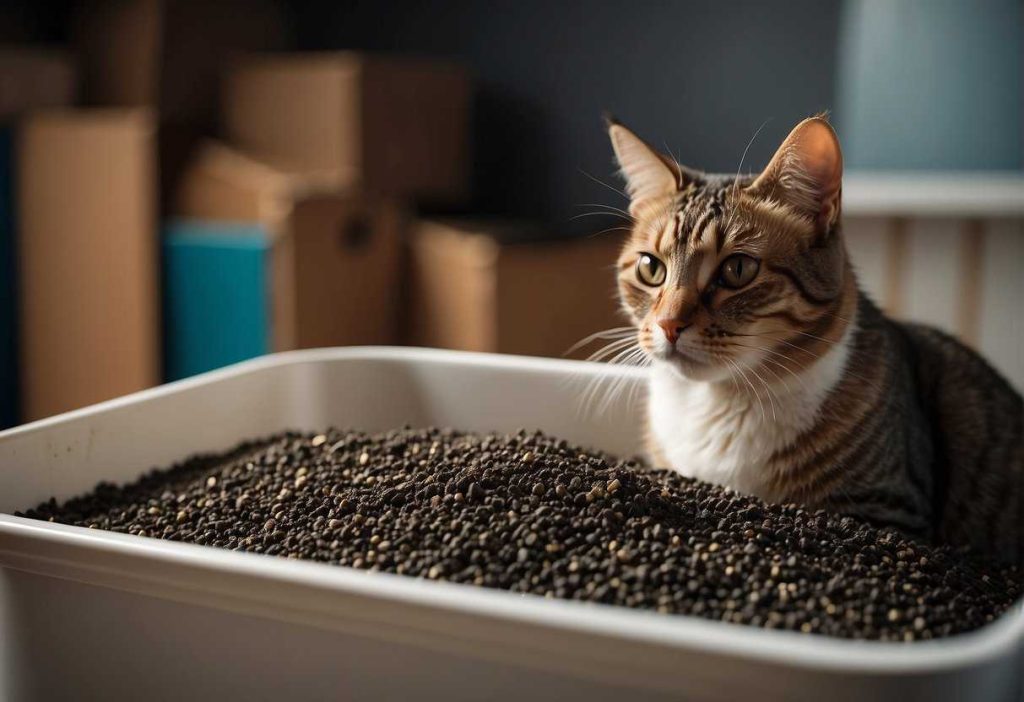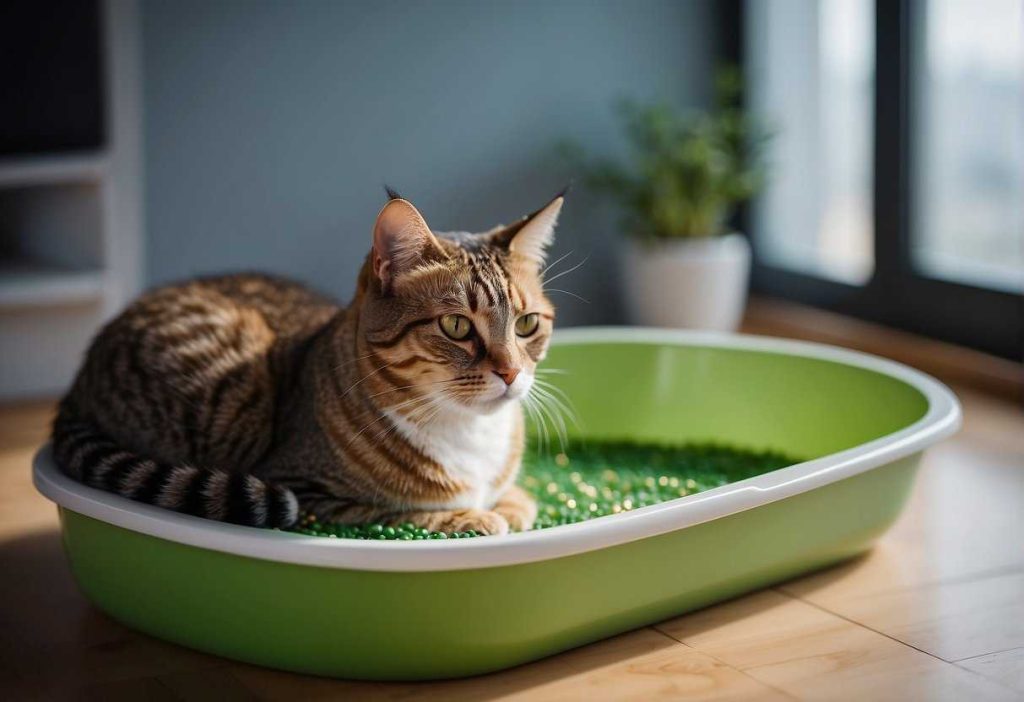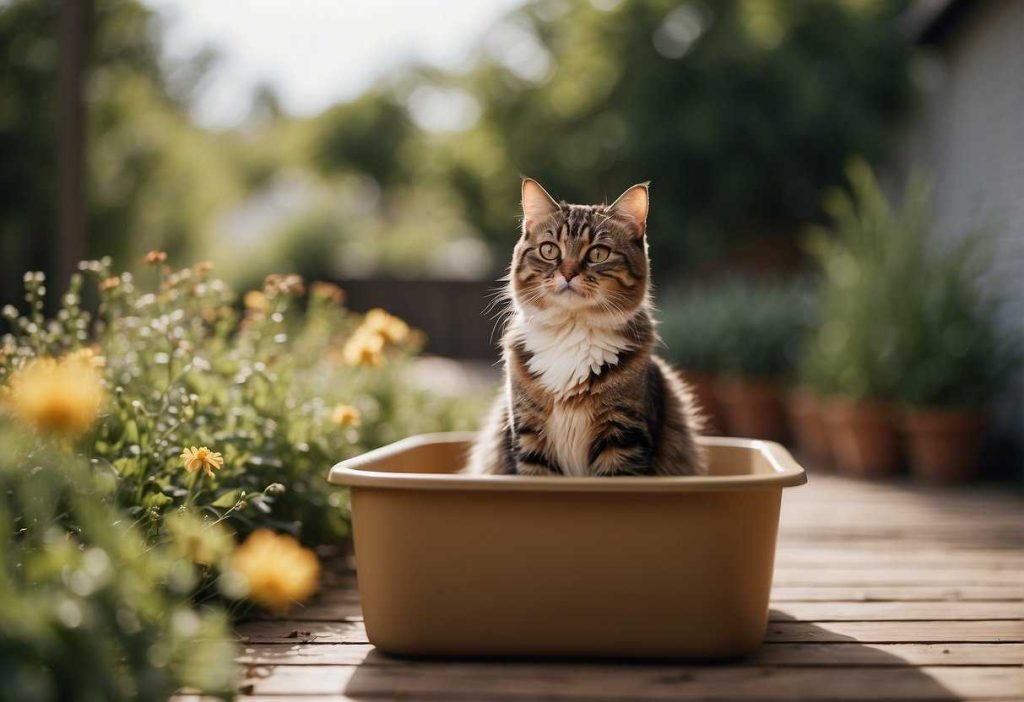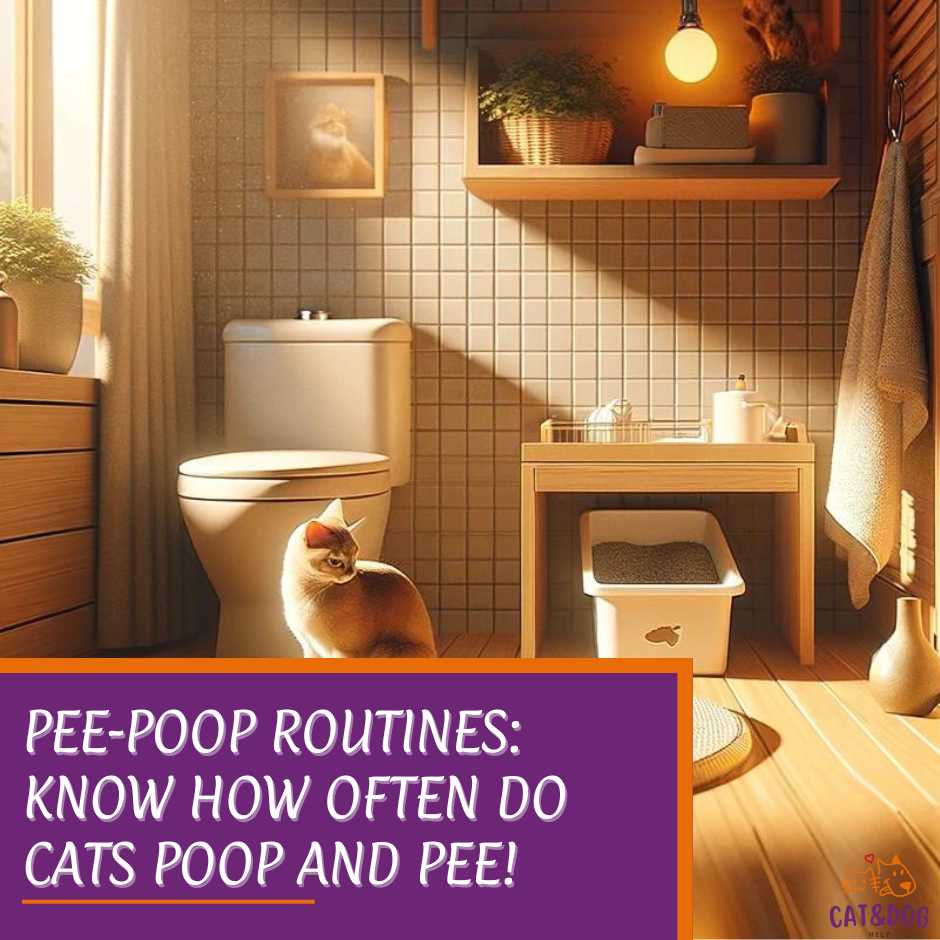Understanding your cat’s litter box habits is key to monitoring their health and well-being. How often cats poop and pee can vary widely based on factors such as diet, age, and individual health. (1)
Most healthy adult cats will urinate two to four times per day and typically defecate every 12 to 36 hours.
However, these are just general guidelines, as some cats may go more or less frequently depending on their cat’s health and a general rule of thumb is that pooping once or twice daily is considered normal for cats.

When it comes to kittens and younger cats, their bathroom habits can be more frequent due to their developing bodies and faster metabolisms. (2)
Conversely, older cats often have slower metabolisms and may not need to eliminate waste as often.
Being attuned to what is normal for your cat can help you quickly identify any changes that may indicate a health issue, warranting a vet visit.
Litter box behavior not only provides insight into a cat’s physical health but can also reflect their mental state. Sudden changes in litter box usage could signal stress or discomfort.
Paying close attention to your cat’s bathroom patterns is an essential part of caring for your feline friend.
Key Takeaways
- Bathroom frequencies for adult cats typically range from pooping every 12 to 36 hours and urinating two to four times daily.
- A cat’s age, diet, and health influence their litter box habits, with kittens and elder cats often deviating from the average ranges.
- Changes in elimination habits can indicate health or behavioral issues, highlighting the importance of monitoring their bathroom behaviors.
Introduction to Cat’s Litter Box Habits
Monitoring a cat’s litter box is like reading a diary that offers insights into their health. Bowel movements can speak volumes about a cat’s digestion, diet, and overall well-being.
Cats typically defecate once or twice a day, although this can vary with diet, hydration, and age.
Diet is a major player in the consistency and frequency of a cat’s poop. (3)
High fiber content, for example, can mean more frequent trips to the litter box, also known as frequent bowel movements. Conversely, diets low in fiber may lead to constipation.
Hydration also matters – not enough water can result in hard stools, while too much may lead to diarrhea.
Consider getting a wet food that’s easy to digest and incorporating it into your cat’s diet to ensure proper hydration and digestion.
Probiotics are also a great way to aid in digestion and can be easily added to your cat’s diet.
One should consider a cat’s age as their metabolism changes over time. Kittens, with their growing bodies, might visit the box more often. Older cats, with slower metabolisms, might poop less.
The color, shape, and presence of mucus in cat poop can indicate health issues.
For instance, black or tarry stools might suggest internal bleeding, while the presence of worms or mucus could signal parasites or inflammatory bowel disease.
But not every sign is dire! A healthy cat’s poop should be deep brown with a consistent shape and without any visible mucus or blood – now that’s a victory in any cat caretaker’s book!
Remember, changes in your furry friend’s defecation habits, such as frequency or consistency, often warrant a chat with their vet.
Poop problems like constipation or diarrhea might be more than a passing issue; they could point to food allergies or intolerance, so it’s important to pay attention to your cat’s cat’s poop and ensure it is healthy.
So next time you scoop, pay attention to what’s left behind. It could be the clue you need to keep your feline friend happy and healthy!
The Basics of Cat Poop and Pee : How Often Do Cats Poop and Pee?

When it comes to understanding your furry friend’s health, monitoring their litter box habits is key. Let’s talk about what’s normal and what’s not, shall we?
What’s Normal and What’s Not?
Normal Poop and Pee Frequencies
- Healthy cats typically defecate once every 24 to 36 hours, though this can vary.
- An ideal urination frequency for a cat is about two to four times daily.
- Keep a log and check the litter box to ensure they’re on track.
Recognizing Signs of Physical Health Issues
- Less than once every 48 to 72 hours for poop, or more than three times could mean trouble.
- With pee, less than once a day or more than six times signals an issue.
How Often Do Cats Poop?
A cat’s elimination habits tell a lot about their overall health. Here are some digits:
- Once a day is common for pooping, yet some healthy cats may go less or more.
- Twice to three times a day is a typical range for pee breaks. It’s vital for hydration levels.
Now, if your furry buddy is deviating from these patterns, consider factors like water intake—hydration is a biggie! Too little and you’ve got dehydration, too much could indicate other health concerns.
When to Worry?
If the kitty’s appetite wanes or the litter box reveals a change, there’s cause for attention.
Consistent changes or extremes in frequency, texture, or color could suggest health issues or underlying medical conditions. In these cases, a vet visit is non-negotiable.
Remember, consistency is a telltale sign of a healthy cat. Keep a vigilant eye on their elimination—it’s crucial for catching health issues early. (4)
If there’s a significant alteration in their habits, medical intervention may be just what the veterinarian ordered to steer clear of an emergency.
Beyond the Basics: Behavioral Insights and Relationship Building

Stress factors, such as a new pet or moving house, can disrupt their digestion and, in turn, their litter frequency. (5)
This is because the digestive system of cats is closely linked to their overall health and can be affected by various factors, making it important to pay attention to their bathroom habits.
Diet plays a starring role in litter box behavior. Cats on a high-fiber diet might find themselves visiting the little sandbox more often due to the nature of fiber-promoting digestion.
Conversely, cats on a low-fiber diet or those experiencing dehydration may have a penchant for constipation. This can result in less frequent trips to the litter box to pee and poop.
Moisture is vital — both wet and dry food serve their purpose, but wet food can be especially beneficial for hydration and preventing urinary issues.
Additionally, a clean litter box is important for cats to feel comfortable and continue using it for their feces and urine.
Some kitty parents scoop immediately after their cat uses the box to help it stay clean and minimize odor.
If you’re a scoop-after-each-poop-or-pee-parent, you’ll want cat litter that absorbs wetness quickly and coats feces to create hard clumps that are easier to remove.
Adding supplements to your cat’s diet can also help improve their overall health and digestion, leading to better litter box habits.
Interpreting what your cat is silently communicating can be challenging.
A cat suffering from food allergies or digestive problems might avoid the litter box due to discomfort associated with eating. It’s their way of saying, “I’m not feeling my best!”
To strengthen your bond and foster a positive litter box experience, consider these tips:
- Ensure their box is in a stress-free zone.
- Keep it clean — a dirty box can discourage use.
- Rule out health issues with a vet visit if there’s a noticeable change in habits.
If faced with litter box issues, remember to react with patience and understanding. Cats are sensitive creatures, and building trust is paramount.
Addressing these matters with a gentle approach can solidify your relationship.
Encouraging them gently can turn a litter box challenge into an opportunity for growth in your shared companionship.
After all, every loving “meow” and successful bathroom trip is a step forward in your lifelong friendship.
Practical Tips for Everyday Cat Care

Creating a Cat-Friendly Litter Box Environment
Cats cherish their privacy, and when it comes to their bathroom habits, it’s no different. They prefer a quiet, secluded spot for their litter box, far from the hustle and bustle of daily life.
It might be a good idea to have one more box than the number of cats in the home to avoid any territorial issues. Remember, if the location feels safe, they are less likely to seek alternative spots for relief.
Choosing the Right Litter Box and Location
- Select a litter box that is spacious enough for your feline friend.
- Place the litter box in a low-traffic area, away from their food and water.
- Consider the style of the box; some cats prefer open-top, while others like hooded varieties.
Litter Box Maintenance for Health and Happiness
- Scoop the litter box at least once a day to keep it clean and fresh.
- Completely replace the litter and wash the box regularly to prevent odors.
A cat’s refusal to use the litter box might indicate stress or dissatisfaction with the cleanliness of their space. Observing their behavior can inform changes in maintenance routines.
Addressing Common Litter Box Issues
It can be puzzling when a well-trained cat suddenly avoids their box. Are they stressed? Have there been changes in the household, like moving? Such events can affect a cat’s behavior.
Consistency in the environment and swift clean-ups of accidents can help alleviate their anxiety.
Health-Related Litter Box Concerns
Cats usually urinate two to four times daily and defecate approximately once a day.
If a cat’s bathroom habits change dramatically – whether they’re visiting their box more often or less – it may point to health conditions such as chronic kidney disease.
A significant delay in elimination, especially more than 48 to 72 hours, calls for professional advice, especially for male cats who are more prone to urinary blockages.
If they’re displaying signs of discomfort, it’s essential to consult with a vet.
By understanding and catering to a cat’s bathroom needs, pet owners can ensure a happy, hygienic home life for their beloved companions.
Remember, it’s not just about the litter box; it’s about the comfort and health of your furry friend. (6)
Enhancing Mental and Physical Well-Being Through Litter Box Care

Caring for a litter box goes beyond scooping and cleaning; it’s about understanding the subtle cues your furry friend gives you!
Did you know that a cat’s visit to their little sandbox can be a barometer for their well-being? Here’s the scoop:
- Frequency matters: A healthy adult cat typically graces their litter box two to four times a day for urination. Now, if your senior feline is making more frequent trips—or maybe less—it might hint at conditions like kidney disease or hyperthyroidism.
- Hydration and diet: Just like with humans, what goes in affects what comes out. Make sure they’re hydrated and on a balanced diet. Too little water or the wrong food can lead to constipation or diarrhea.
Here’s where it gets interesting:
- Mental peace: A clean and easily accessible litter box doesn’t just prevent “accidents,” it gives your cat a sense of security and satisfaction. Think of it as their spa where they can relax without stress.
And remember, responding to litter box habits isn’t just about cleanliness or health; it’s about building that bond. When they notice you’re attentive to their “bathroom” needs, it strengthens your connection.
- Behavioral cues: Acting out? Missing the mark? Before you get into a hiss-y fit, consider that it might be a cry for help or a sign of dislike for their current potty situation.
So, scoop with a smile, and keep an eye on those litter box tales.
Your feline’s frequency, hydration, and diet are not just health markers, they’re key to a happy, stress-free life for both of you. Who knew a bit of litter could lead to a lot of love?
Quick Recap

Here’s a snapshot of what typical litter box usage should look like:
- Frequency: Cats typically pee 2 to 4 times a day and poop about once a day, though this can vary.
- Dietary Influence: The amount and type of food, especially wet versus dry, can impact how often your cat visits the litter box.
- Age Factors: Kittens may go more often, while senior cats might have slower bathroom schedules due to a decrease in metabolism.
Medical conditions ranging from mild to severe can alter these norms:
- Urinary issues: Could indicate bladder stones or infections and require prompt veterinary attention.
- Inflammatory bowel disease: This could affect gut motility, leading to changes in poop frequency.
- Feline megacolon: Stool passage difficulties could be a sign of this serious condition.
- Spinal problems: Issues with nerves could impact bladder and bowel control.
- Parasites: Worms or other intestinal parasites could alter bathroom habits. (7)
Don’t forget to stay vigilant with litter box monitoring as it can reveal a lot about a cat’s well-being:
- Changes in habits: Watch for deviations from their normal patterns.
- Colitis: Look out for signs like diarrhea or frequent defecation.
Key pointers for keeping your furry friend healthy include:
- Consistent monitoring: A daily check to notice any differences in habits.
- Seeking advice: Contact a vet if you’re concerned about changes in frequency or consistency.
In essence, keeping a close eye on these aspects conveys your care and commitment to their health, and trust us, they feel the love!
Frequently Asked Questions

Navigating your feline friends’ bathroom habits can be puzzling, but key indicators and timely actions can help maintain their health and happiness.
Why is my cat suddenly avoiding the litter box?
Cats may begin to avoid the litter box due to various reasons such as stress, displeasure with the cleanliness of the box, or health issues like urinary tract infections.
Identifying changes in the environment or their routine can also help in understanding the cause.
How can I tell if my cat’s litter box habits indicate a health problem?
A deviation from normal patterns, like increased frequency of urination or signs of discomfort while defecating, may suggest health issues.
Monitor for any alterations in the consistency, color, or smell of their waste as these can be early indicators of problems.
What’s the best way to introduce a new litter box to my cat?
Introduce the new litter box by placing it close to the old one.
Encouraging exploration and ensuring the new box is appealing, clean, and filled with familiar litter helps ease the transition for your cat.
How often should I clean my cat’s litter box to keep them happy?
To keep cats content, their litter box should be scooped daily and the litter changed completely at least once a week.
This frequency helps prevent odors and maintains a sanitary environment for the cat.
Can the type of litter I use affect my cat’s bathroom habits?
Yes, cats can be finicky about the texture and scent of litter. Some may avoid the box if the litter is displeasing.
Offering an unscented, fine-grained litter often encourages proper litter box use by making it more appealing to feline friends.
What are some effective ways to manage multiple cats’ litter box needs?
To manage multiple cats effectively, offer a litter box for each cat, plus one additional, and position them throughout the home.
Frequent cleaning and monitoring each cat’s individual habits are crucial for harmonious cohabitation.
- How to Perform at an Online Casino - July 7, 2025
- Free Slots With Bonus and Free Spins - July 6, 2025


